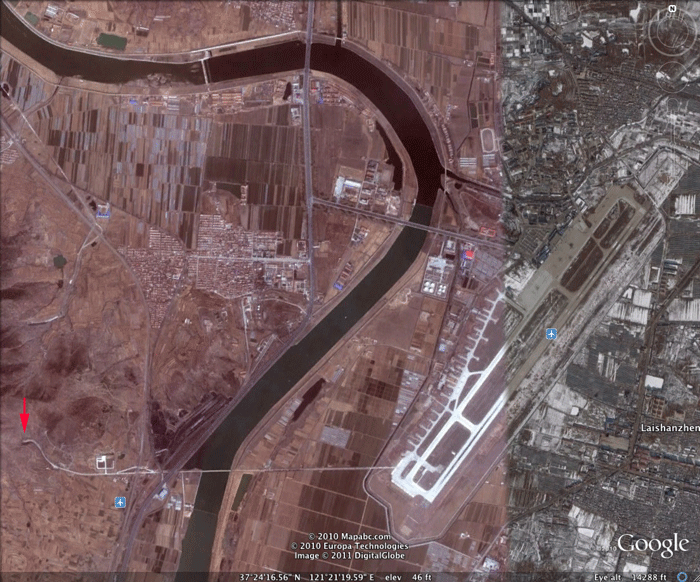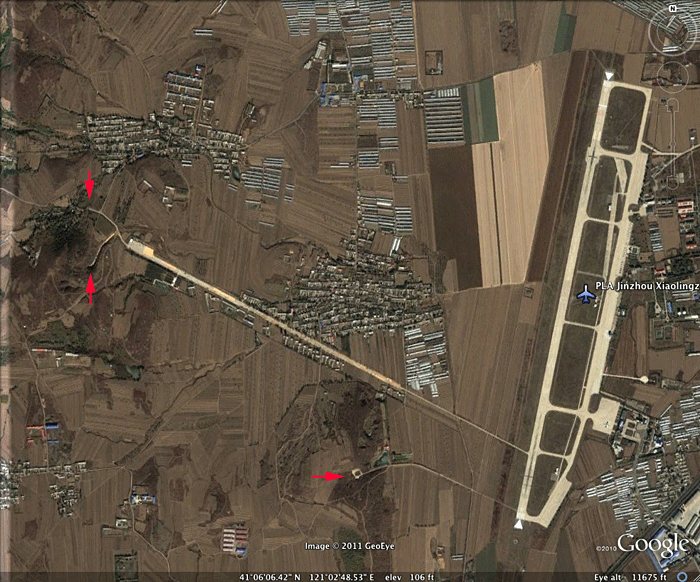

China's Air Force Goes Underground!
Other than a direct hit from an asteroid, China's Air Force can withstand almost anything anyone can hurl at it. While America has been fighting expeditionary wars and consolidating its military bases, China has been forrowing its fleet of fighters and bombers in reinforced hangars, deep underground.
Accessible to everyone, thanks to the amazing technology of Google-earth, images like the one below reveal the runway of this strategic air base, but nothing more. On closer examination, two paved taxiways lead to opposite sides of a mountain [red arrows] which houses the actual hangars and base command.

People's Liberation Army, Yongning Air Base (China)
Same -- but Different
The runway configuration has changed little from the Soviet era. There is usually one wide main runway with a parallel taxiway that can be used as a secondary runway.

Abandoned Soviet-era air base bordering Mongolia
Taxiways from both ends of the runway complex fanned out to individual earth berms where the aircraft were stored, serviced and armed. The image above is that of an abandoned Soviet-era air base near the border of Mongolia. It's typical to see the old bases appear ransacked so as to validate (to those observing satellite images) that the bases have been decommissioned.
The biggest dangers to aircraft on the ground are from strafing by other aircraft and the tremendous overpressure from a nuclear explosion. Surprisingly, the heat blast is mitigated by the high infrared reflection of the aluminum skin. While the paint would vaporize, the heat would not significantly damage the aircraft.
Enclosing the aircraft in a deep earth berm at one time impeded the ability of an attacking aircraft to fire on it. The attack required a steep dive to be effective. Today, aircraft like the A-10 Warthog are specifically designed for this angle of attack. So-called "smart bombs" can also achieve this angle.
Overpressure and electromagnetic pulse (EMP) from nuclear bombs made all above ground aircraft vulnerable and berm protected bases obsolete. By 1963, the plans for moving underground were already being implemented. Where the topography and geology allowed it, runways were built next to mountains or hills made from granite. Existing bases were altered to provide access to underground hangars, some even before the underground construction had begun.
Although the underground hangar would ideally be close to the runway, sometimes it was as much as two kilometers away, like this example at Yantai which even crosses a river.

(PLA) Yantai Air Base (China)
China has the Strategic Advantage

(PLA) Jinzhou-Xiaolingzi Air Base (China)
[Above] This is another example of an underground base at Jinzhou-Xiaolingzi. Besides the advantages of surviving an attack, these huge underground bases allow for clandestine preparations -- potentially a first strike capability -- that would be undetected by spy satellites or other intelligence until the aircraft started exiting the shelter.
Taking an exact inventory of fighters and bombers is complicated with the fleet largely underground. Intelligence specialists know of at least 40 hardened underground air bases in China, capable of holding and servicing more than 1,500 aircraft -- more than the current estimate of aircraft in the People's Liberation Army.

The basic idea is for the aircraft to be housed in a tunnel, with an entrance and an exit. Like a hornets leaving their nest, the fighters emerge one-by-one from the underground exit and take off from the runway. Upon returning, they taxi to the entrance where, safely inside, they are serviced, re-armed, fueled and sent off on another sortie.
No known photos are available of the insides of functioning underground air bases today; however, an air force museum at Datangshan has been constructed inside a decommissioned underground air base and it reveals a much more complex design [above right and below] with large rooms for making repairs or for storing arms.

Blending Into the Countryside
Compared to the somewhat sterile landscapes surrounding the security perimeters of most USAF bases, the Chinese have a pension for landscape and gardening that minimizes the environmental impact of their underground bases. If not pointed out to observers, the imagery of these bases could easily be overlooked and mistaken for farmland.

This base at Guiyang [above] has been built inside a local hill and has four openings that converge on a long runway, flanked by neatly squared fields of vegetation.
Some strategic bases are located in flat land with no hard mountains or topography which facilitate the construction of underground facilities. Hardened concrete shells house the aircraft, often reinforced with earth piled on top, and the entire complex is painted or camouflaged to look like a park or tree farm from altitude.

The blast doors are especially designed to deflect the overpressure of an atomic bomb. Unlike American bases, where taking such a photo would likely get you shot, these underground bases look passive aside from periodic tests and alerts.
Having the largest military in the world, China is not aggressive and does not seek to dominate other nations, despite its strength. Instead of building bases in foreign lands, China is more likely to be seen building bridges, dams, irrigation projects and highways for developing nations. This is especially evident in countries like Yemen and many nations in Africa.
Conflicts between the US and China are unlikely since both rely upon each other for trade and monetary stability. The only conflict of a militant nature has to do with the claim, asserted by mainland China, that the island of Taiwan is part of their nation. The US recognizes Taiwan as a sovereign nation. Other future conflicts are likely to arise over oil resources as China's growth continues amidst a declining supply.
Perhaps China is preparing for this inevitable day. If so, they are decades ahead of other countries, including the USA, at protecting and surviving a conflict on their mainland.
One more...


These images are of the underground base at Pingquan. The Google-earth images are very clear and impressive. I welcome anyone who can send pictures of US Air Force underground facilities. Again, the Chinese have over 40 of these bases now. What does it all mean?
Many thanks to ausairpower.net and Google-earth for photos.



